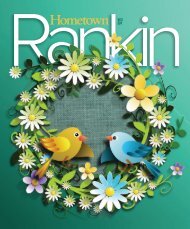Madison123
You also want an ePaper? Increase the reach of your titles
YUMPU automatically turns print PDFs into web optimized ePapers that Google loves.
here at the front porch,” she says,<br />
pointing toward the door.<br />
My grandfather chimes in from his<br />
chair across the room. “Real, or fake?”<br />
he asks, and my grandmother laughs<br />
in response. They’re fake silk flowers<br />
buried in the real dirt, and they bloom<br />
year-round.<br />
“You’d think with all the time I’ve put<br />
in it, I would have a better garden than<br />
what I turn out to have,” she says. “I just<br />
really haven’t had space anywhere that<br />
I’ve lived to have very much of a garden,<br />
you know.”<br />
My grandmother, who was named<br />
Willie after her grandmother and Ruth<br />
after her mother, grew up in the garden.<br />
Born in southern Alabama but raised in<br />
central Mississippi, she lived with her<br />
family on property owned by the man<br />
they raised crops for. In the small family<br />
garden by their home, she helped by<br />
shelling peas, and they lived off what<br />
they could grow.<br />
The first garden of her own was in<br />
the backyard of her home on Lawrence<br />
Road in Jackson, Mississippi. There, she<br />
raised two daughters and lived for nearly<br />
forty years. During the weekdays, she<br />
worked in the daycare at their church,<br />
Briarwood Baptist, taking care of<br />
three-year-olds who called her “Miss<br />
Roofie.” Her vegetable garden sat across<br />
the length of the yard’s left edge, and<br />
carefully planted wildflowers ran down<br />
the other two sides of the chain-link<br />
fence. In the center of the yard sat an<br />
old peach tree covered in fine mesh to<br />
keep out squirrels, and two silver metal<br />
clothesline posts. In the summer, sunlight<br />
made its way through the canopy of the<br />
giant, ancient oak trees that dotted the<br />
old neighborhood.<br />
When they moved to the trailer in<br />
2005, they dug up the concrete<br />
stepping-stone that sat in front of the<br />
gardening shed in the backyard and took<br />
it with them. It had my mother’s name,<br />
Debra Henderson, engraved into the<br />
wet cement with a pointer finger, and<br />
the year, 1968.<br />
In the new home, my grandmother<br />
immediately picked the best spots for<br />
her new garden, which flanked the trailer<br />
home on opposite ends. My uncle tilled<br />
up the soil for her, and she set to work.<br />
When it got harder for her to walk down<br />
the steps and across the yard, we got her<br />
the motorized wheelchair. After this,<br />
she put her trowel and gardening claw<br />
in the chair’s side pocket and began<br />
dragging the watering hose behind her<br />
across the yard.<br />
At the end of every autumn, she<br />
would say that season was her last to<br />
work in the dirt. “I’m not doing a garden<br />
next year,” she would tell us. We bought<br />
her the most realistic-looking silk flowers<br />
we could find, and she planted them by<br />
the mailbox and in hanging baskets<br />
along the back porch. But one Sunday<br />
afternoon each spring, we would pull up<br />
in the gravel driveway to see freshlytilled<br />
earth, tree branches serving as bean<br />
poles, and evenly-spaced mounds of dirt<br />
with tiny green sprouts breaking free.<br />
One particular Sunday, while sitting<br />
in the living room as a brightly-colored<br />
NASCAR race swirled silently around<br />
on the TV, I asked her what it is about<br />
gardening that she likes so much.<br />
“I don’t know,” she said, laughing.<br />
“I just do.” Sitting in her recliner, she is<br />
wearing two pairs of fuzzy pink socks as<br />
well as house shoes, and her feet barely<br />
touch the floor. “I just like to go outside.<br />
I could stay out there all day.” With this,<br />
she pauses and turns to my grandfather,<br />
who is nodding off in his own chair.<br />
“Couldn’t I, Shelton?” she asks him.<br />
He picked his head up and doesn’t miss<br />
a beat. “You do,” he responds. “You do<br />
that sometimes.” He tells us that when<br />
the weather is good, she’ll go out at ten<br />
and won’t come back in until two or three.<br />
“I like to do butter beans…” she says,<br />
looking off in the distance. “I like to have<br />
butter beans, and okra, and tomatoes,<br />
and squash–which I don’t have good<br />
luck with, squash.” She continues,<br />
“Onions, strawberries, blueberries…<br />
peach trees, pear trees, plum trees. If<br />
they’re good plums, they’re about like<br />
that,” she says, holding up her fingers<br />
to show an imaginary, golfball-sized<br />
piece of fruit. “This past year I didn’t<br />
have good plums because half of it….<br />
Well, I only had half a plum each.”<br />
That year, she carefully picked each<br />
plum, half not quite ripe, the other half<br />
already turning bad. Setting them in<br />
her lap on the wheelchair, she brought<br />
the small pile into the house each day.<br />
She would then carefully peel each piece<br />
of fruit, keeping only the parts that were<br />
good. Little by little, she amassed enough<br />
that summer to make a few jars of jelly,<br />
which she gave to us.<br />
“There are some vegetables that just<br />
take too much time to plant and peel,<br />
Mama,” my mother always told her.<br />
“You can buy them at the store and<br />
they taste just as good.”<br />
“Yeah, but I still wanna’ put ‘em up,”<br />
she said, laughing.<br />
During my sophomore year in<br />
college, I came home for the summer<br />
determined to grow my own garden in<br />
the backyard. I purchased several seed<br />
packets at the local yard and garden<br />
center: giant sunflowers, heirloom<br />
tomatoes, California poppies, dark green<br />
cucumbers. I planted the seeds in egg<br />
cartons filled with soil and watched<br />
them peek out of the dirt, their tiny green<br />
bodies stretching toward the kitchen<br />
window’s sun.<br />
In the heat of June, I used a longhandled<br />
shovel to break up the hard<br />
Mississippi clay and mixed it with new,<br />
rich, black soil, burying the roots of<br />
each sprout an even six-inches apart.<br />
I punctured the dirt with the ends of<br />
freshly-pruned crepe myrtle branches<br />
42 • JANUARY 2023 Originally published April 2019

















